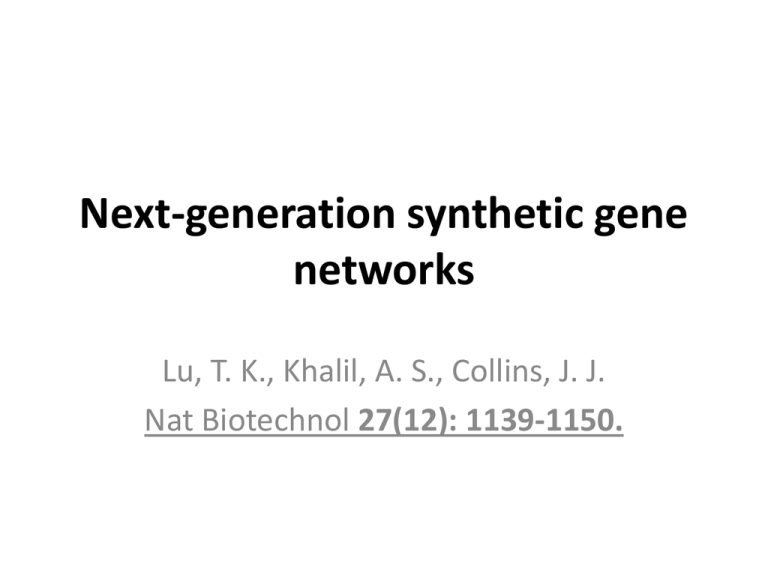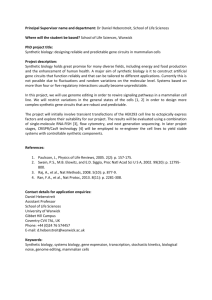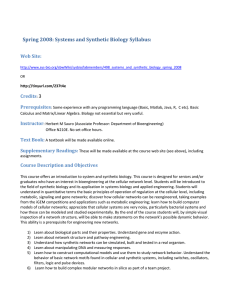Next-generation synthetic gene networks 27(12): 1139-1150.
advertisement

Next-generation synthetic gene networks Lu, T. K., Khalil, A. S., Collins, J. J. Nat Biotechnol 27(12): 1139-1150. Synthetic biology in the past • 10 years since the first synthetic devices – The genetic toggle switches and repressilator • Artificial gene circuits – Switches, oscillators, digital logic evaluators, filters, sensors and cell-cell communicators • Industrial and medical applications –… Problems with synthetic biology • No well-established frameworks for handling complexity, reliable means of probing and manipulating system states and the use of testing platforms • The design cycle for engineering synthetic gene networks remains slow and error prone • Advances in molecular construction and computational modeling Four important research efforts for nextgeneration synthetic biology 1. Advancing and expanding the toolkit of available parts and modules 2. Modeling and fine-tuning the behavior of synthetic circuits 3. Developing probes for reliably quantifying state values for synthetic (and natural) biomolecular systems 4. Creating test platforms for characterizing component interactions within engineered gene networks, designing gene circuits with increasing complexity and developing complex circuits for use in higher organisms Interoperable parts and modules for synthetic gene networks • Synthetic biology toolkit of available parts and modules • Engineered zinc fingers – a source of interoperable transcription factors • Nucleic acid–based parts, such as RNAs – siRNA, Recombinases Modeling and fine-tuning synthetic gene networks • Multi-step design cycle – creating diverse component libraries – constructing, characterizing and modeling representative network topologies – assembling and fine-tuning desired circuits – subsequent refinement cycles • Tuning gene expression by altering transcriptional, translational and degradation activities – promoter libraries, RBS sequences, protein degradation Probes for characterizing synthetic gene networks • Tracking the in vivo operation of synthetic gene circuits in a high-throughput fashion • Microfluidic devices – provides a useful platform for perturbing synthetic gene circuits with well-controlled inputs and observing the outputs in high-resolution fashion • Quantitative probes – fluorescent proteins, mass spectrometry–based methods, quantum dots, radiofrequencycontrolled nanoparticles Test platforms for engineering complex gene circuits • Increasing complexity – assembling larger synthetic gene networks from smaller ones – engineering circuits into higher organisms • Test platforms verify or debug circuit topology and basic functionality – Cells with minimum genomes, orthogonal parts, artificial codons and unnatural amino acids • lower-organism test platforms Next-generation gene networks • Yield insights into the principles that guide the operation of natural biological systems • Highlight design principles and/or provide modules that can be applied to the construction of other useful synthetic circuits • Advance the tools available for novel scientific experiments • Enable real-world applications in medicine, industry and/or agriculture Tunable filters and noise generators • Filter characteristics can be adjusted by tuning the degradation of RNA and protein effectors in negativefeedback loops. Examples of RNA effectors include siRNAs, riboregulators and ribozymes. Examples of protein effectors include transcriptional activators and repressors. In this example, the P1 promoter is suppressed by transcriptional repressor proteins expressed from the Repressor 1 gene. Analog-to-digital and digital-to-analog converters Adaptive learning networks Associative memory circuit enables association between two simultaneous inputs (‘Activator A’ and ‘Activator B’) so that the subsequent presence of only a single input can drive its own pathway and the pathway of the other input. Switch P1/P2 is initially set so that P1 = 1, P2 = 0 Adaptive learning networks Winner-take-all circuit allows only one input out of many to be recorded. This effect is achieved by a global repressor protein that gates all inputs and prevents them from being recorded if there has already been an input recorded in memory. Protein-based computational circuits • Post-translational • Subcellular location • Shorter time scales Amyloid-based memory. (a) Amyloid-based memory can be implemented by fusing a prionogenic domain (PD) to an effector gene, such as a transcriptional activator. (b) Overexpressing the prion-determining region via promoter ‘POFF’ causes aggregation of the fusion protein, rendering the effector inactive. (c) Subsequent overexpression of chaperone proteins (e.g., HSP104), which act to disaggregate amyloids, via promoter ‘PON’ releases the effector from the amyloid state and enables it to fulfill its function. Inputs into promoters and logic operations are shown explicitly except when the promoter name is italicized, which represents an inducible promoter. Engineered circuits for biological containment Recombinase Cell-cycle counter for biological containment. Cell-cycle counting is accomplished with a cascade of single recombinase-based memory units (e.g., SIMMs9), each of which is driven by a cell cycle–dependent promoter. After N cell-cycle events are counted, the gene circuit unlocks the expression of a toxic protein triggering cell death. Protein degradation tags (ssrA) are fused to the recombinase genes to ensure stability of the circuit. Whole-cell biosensors and response systems Other applications • Intercell signaling circuits and pulse-based processing for genetic oscillators • Designer circuits and systems for microbiome engineering • Switchboard for dynamically controlling the expression of multiple genes Project Ideas • Analog Computer (Generic) • Specific Analog Computer Apps – Solve odes – Analog arithmetic • Analog components – – – – • • • • • • Multipliers Filters Differentiators Subtractors/Summers Phase locked loop Synchronized oscillators FM/AM encoding and decoding Band pass filters Tick Tack Toe game Traveling salesman problem (shortest route to visit cities)






